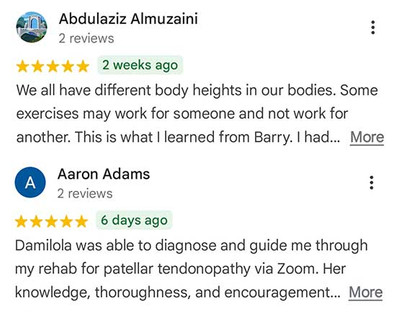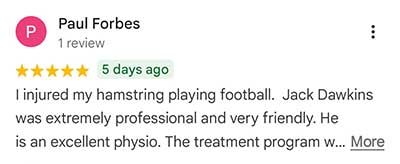Yes, warming up prevents injuries. Here's how.
- Maryke Louw

- Jul 25, 2018
- 5 min read
Updated: Jul 20, 2024
I can probably count on one hand the number of patients I see in clinic every week who actually do a proper warm-up before they exercise. I suspect the main reasons for this low number are (1) that they’ve been able to get away with not warming up and avoided injury until now and (2) that they don’t actually understand why a warm-up is important. In this article, I first look at what the research says regarding the link between warm-ups and injury prevention and then at how exactly warm-ups prevent injuries. Remember, if you need more help with an injury, you're welcome to consult one of our physios online via video call.

In this article I’ll discuss:
We've also made a video about this:
Does warming up prevent injuries?
There is strong evidence that a thorough warm-up routine can prevent injuries in all parts of the body. For example, the FIFA11+ warm-up programme that was developed for football/soccer has been shown to decrease the number of injuries a team racks up in a season by up to 30% while it can decrease severe injuries by 50%!
Research done in rugby (school level as well as adults) has shown that you can even reduce the number of concussions players get if they warm up properly.
You’ll notice that I use the words “thorough” and “properly” in the paragraphs above. Not all warm-up routines are equal. Running slowly for the first 5 minutes of a run or doing a quick jog around the pitch before you play football does not count as a warm-up! It has to include specific types of exercise to be effective, and I discuss these in detail in the second article of this series.
A second benefit of warming up is that it improves your performance. Researchers have found it can improve a wide variety of performance markers, including sprint times, jump height, agility skills, and balance, to name but a few.
This is because a well-designed warm-up programme prepares your joints, muscles, and nerves for exercise, and I’ll discuss in more detail below exactly how it does this.

Getting the range you need
A good warm-up routine will always start with gentle aerobic exercise that improves the viscosity of your joint fluid, which helps them to move better. It further includes dynamic stretches that take your muscles and joints through the full range of motion that you need for your sport.
The range of motion that you need in your joints and limbs to effectively do your sport will very much depend on what sport you do. Think for instance of a gymnast vs. a sprinter.
The gymnast will require a large range of motion in their hips and may even have to do the splits during their routine. The sprinter only requires the range of motion that will allow them to swing their legs freely through the full running cycle, and excessive flexibility may even negatively impact their performance.
The warm-up routines and goals for these two athletes will be very different. But they will both have to ensure that they achieve the full range of motion that they need for their individual sports before they start training or competing.
Prepping your muscles
A good warm-up will increase your core temperature, muscle temperature, and the blood flow to your muscles, which reward you with stronger and more powerful muscle contractions. It’s easy to see how this will result in better performance.
There is strong evidence that doing a comprehensive warm-up routine two to three times a week not only leads to better performance on the day but also increases your muscle strength over time. How it does this will make more sense when you read the article about the components of the perfect warm-up routine.
Activating your nervous system
Think of your nervous system (brain and nerves) as the captain of a ship (your body). The ship may be nice and strong, but if the captain is drunk or passed out it will not move in its intended way and may even crash (get injured).
An important aim of a warm-up routine is to wake your nervous system up and make sure that it is fully alert and ready for exercise. Your nerves have to make sure that your muscles fire at the right time and intensity and that your limbs move in the correct sequence.
A good example of how switched off muscles (due to the nerves not firing properly) can cause injury is when your glutes (muscles in your bottom) do not activate properly, allowing the knee to turn in while you run. This can cause any number of injuries in the hip, knee, or ankle. One of the top causes for switched-off glutes is when you sit for long periods. I've previously written about how you can wake up and strengthen your glute max and glute med.
Your nervous system is also constantly feeding back information to the brain about where your limbs are in time and space.
Have you ever wondered how you can manage to run down a flight of stairs without really looking at your feet and not trip? This is thanks to proprioception. Proprioception or position sense refers to your brains ability to know exactly where every part of your body is without having to look at it. A good example of what can happen when the brain gets it wrong is when you misjudge the height of a step (as either lower or higher) and stumble or fall.
Poor position sense predisposes you to a variety of injuries. The good news is that there is strong evidence that doing a structured warm-up routine can wake your ship’s captain up and lead to improved static and dynamic balance, agility skills, core and hip muscle activation, as well as core and leg stability.
Now that you fully understand the benefits of warming up, next take a look at what a thorough warm-up routine should include.
How we can help
Need more help with an injury? You’re welcome to consult one of the team at SIP online via video call for an assessment of your injury and a tailored treatment plan.

We're all UK Chartered Physiotherapists with Master’s Degrees related to Sports & Exercise Medicine. But at Sports Injury Physio we don't just value qualifications; all of us also have a wealth of experience working with athletes across a broad variety of sports, ranging from recreationally active people to professional athletes. You can meet the team here.

About the Author
Maryke Louw is a chartered physiotherapist with more than 15 years' experience and a Masters Degree in Sports Injury Management. Follow her on LinkedIn or ResearchGate.











